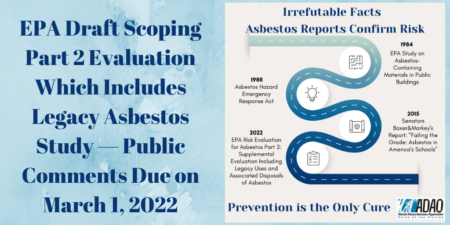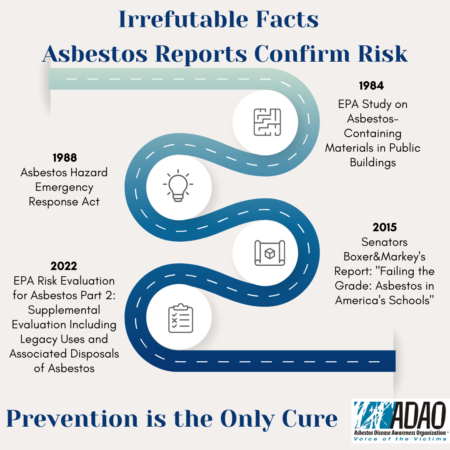Posted on January 31, 2022
 The Asbestos Disease Awareness Organization (ADAO) is pleased that the Environmental Protection Agency (EPA) recently took a critical step in fulfilling its long-delayed obligation to evaluate the risks of legacy asbestos under the Toxic Substances Control Act (TSCA) by putting forth their Part 2 Risk Evaluation for Asbestos. Part 2 will finally provide a robust and comprehensive evaluation of the legacy asbestos that can be found in millions of homes, schools, and workplaces throughout our country.
The Asbestos Disease Awareness Organization (ADAO) is pleased that the Environmental Protection Agency (EPA) recently took a critical step in fulfilling its long-delayed obligation to evaluate the risks of legacy asbestos under the Toxic Substances Control Act (TSCA) by putting forth their Part 2 Risk Evaluation for Asbestos. Part 2 will finally provide a robust and comprehensive evaluation of the legacy asbestos that can be found in millions of homes, schools, and workplaces throughout our country.
The Agency’s Part 1 Chrysotile Asbestos Risk Evaluation was riddled with dangerous gaps and omissions; most importantly, it excluded legacy uses and associated disposals. EPA’s Part 2 evaluation resulted from a lawsuit filed by ADAO, several other public health organizations, and leading scientists. The parties involved agreed to settle this case with a consent decree that establishes an enforceable deadline of December 1, 2024 for EPA to complete the evaluation.
On December 29, 2021, the Agency released its draft Part 2 scoping document. When finalized, this document will provide a roadmap for how EPA will conduct the Part 2 evaluation by identifying the conditions of use and exposure and the risk pathways that EPA plans to analyze, the information sources it intends to access, and the analytical tools it expects to apply.
EPA has provided a 45-day comment period for stakeholders, during which ADAO and our partner organizations have the opportunity to recommend improvements in the draft. The deadline to submit public comments is March 1, 2022.
After reviewing the comments, EPA will issue a final scoping document. We need all organizations and experts who are familiar with the management and risks of legacy asbestos to submit data and recommendations to EPA by the deadline. EPA must receive the best information and advice because this evaluation will determine whether current modes of handling, maintaining, repairing and disposing of legacy asbestos in buildings, factories, products, and articles present an unreasonable risk of injury to human health and the environment.
If EPA determines that current use and handling of legacy asbestos presents an unreasonable risk, TSCA requires the Agency to impose requirements that manage or eliminate the risk. These requirements could be critical in reducing asbestos-related death and disease from legacy asbestos exposure. The last time EPA did a legacy study was nearly 40 years ago, in 1984. That study found one-fifth of all public and commercial buildings had asbestos-containing materials. Now, we finally have the chance to go back and correct the decades-long man-made disaster that is legacy asbestos.
 Legacy asbestos is an old conversation as seen in the:
Legacy asbestos is an old conversation as seen in the:
- 1984 — EPA Study on Asbestos-Containing Materials in Public Buildings
- 1988 — Asbestos Hazard Emergency Response Act
- 2015 — Senators Boxer & Markey’s Report: ” Failing the Grade: Asbestos in America’s Schools” Report
- 2022 — EPA Risk Evaluation for Asbestos Part 2: Supplemental Evaluation Including Legacy Uses and Associated Disposals of Asbestos
Over 40,000 Americans die annually as a result of asbestos-caused diseases. Scientists and public health experts universally agree that there is no safe level of use or exposure to asbestos. While legacy asbestos is now subject to many federal, state and local laws that govern exposure in the workplace and schools, seek to protect construction and maintenance workers, teachers, and the general public from unsafe conditions, a 2015 study conducted by Senators Boxer and Markey found that “the States do not appear to be systematically monitoring, investigating or addressing asbestos hazards in schools [nor do they] report conducting regular inspections of local education agencies to detect asbestos hazards and enforce compliance.” This is, quite simply, unacceptable.
The risk evaluation must take these regulations into account and review their effectiveness in preventing asbestos-related deaths and disease.
The scoping document indicates that the Part 2 evaluation will address chrysotile, crocidolite, amosite, anthophyllite, tremolite and actinolite forms of asbestos as well as winchite and richterite, which are known as Libby Amphibole Asbestos. A comprehensive action plan is incredibly essential to reducing the continued risk of asbestos exposure.
While EPA advances the Part 2 Risk Evaluation and Management, we call on Congress to ban asbestos imports and use. Our lives depend on it.
Linda Reinstein
Social Networks
